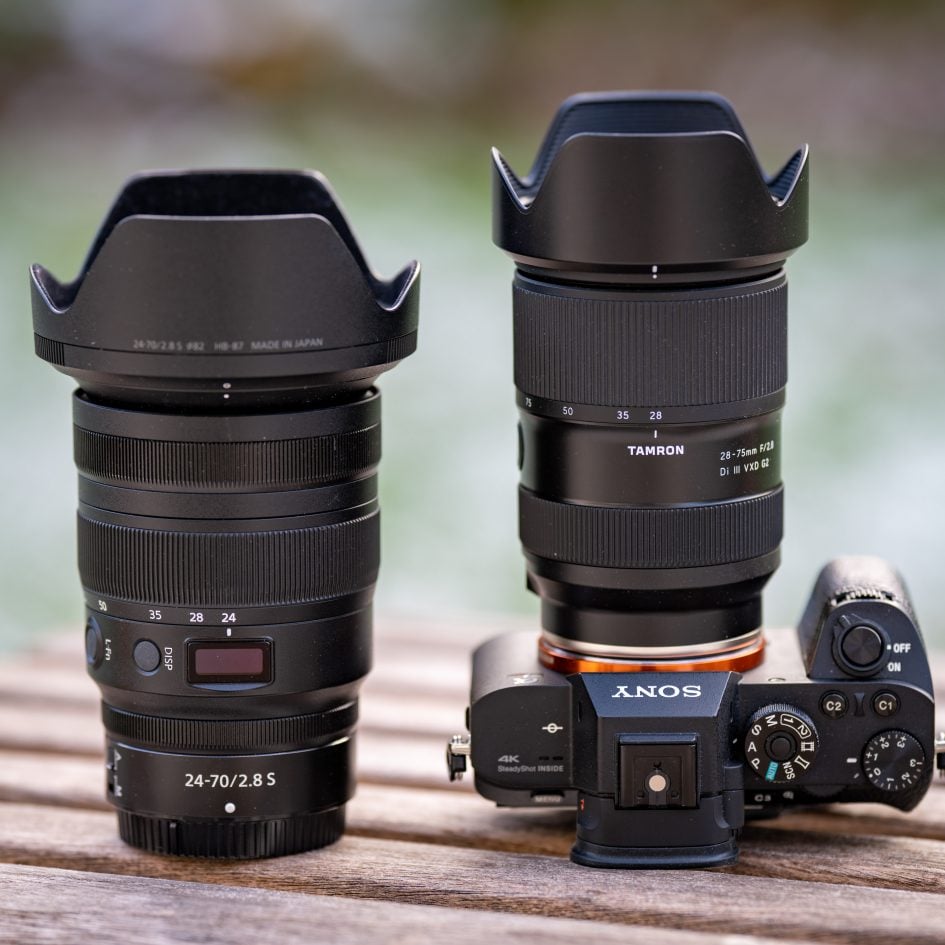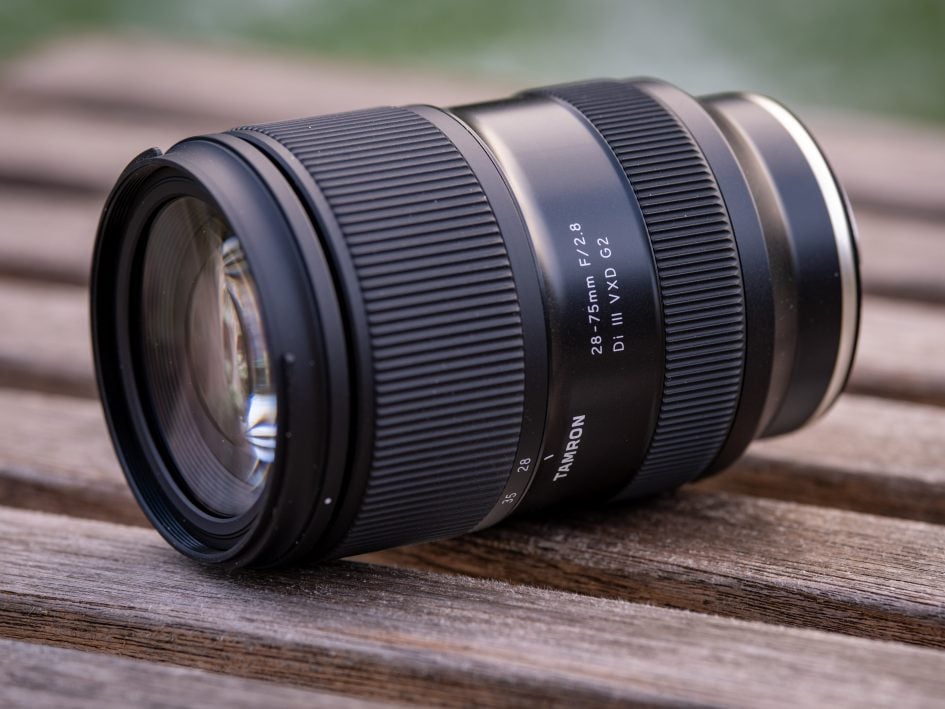Tamron 28-75mm f2.8 Di III G2 review
-
-
Written by Thomas
Verdict
The Tamron 28-75mm f2.8 Di III VXD G2 (model A063) is already the second generation of Tamron’s standard zoom lens designed for mirrorless cameras with full-frame sensors. It is currently only available in Sony E-mount (although we hope RF and Z versions will follow) at 949 EUR / 899 USD / 849 GBP which makes it cheaper than the offers from Sigma, Sony, Nikon, Canon or Panasonic.
The new Tamron has a lot going for it: It is the smallest and by far the lightest standard zoom lens with a constant f2.8 focal ratio available for full-frame mirrorless cameras, The improved optical formula produces good to very good resolution across the full frame and over the complete zoom-range. It also shows very good resistance against flare, glare, and ghosting which lets you shoot confidently under adverse contra-light situation. The lens achieves a magnification of 1:2.5 – 1:3.6 (depending on focal length). It is also thoroughly weather-sealed including a fluorine coating against moisture and dust on the front element and Tamron added a focus set button and USB-C port to make the focus ring and button configurable via computer and Tamron’s new Lens Utility (“TLU”).
What’s not to like? Well, the wide end starts only at 28mm which restricts the widest angle of view to 75 degrees compared to the 84 degrees rivals starting at 24mm focal length offer. And image quality at very close distances is limited especially at the short end: better use the lens at 75mm and stop down to at least f8.0 for close-up shooting.
Let’s put this into perspective and have a closer look at how the Tamron 28-75mm f2.8 Di III G2 compares to its predecessor and the 24-70mm f2.8 zoom lenses from Sigma, Sony, and Nikon.
Above: Nikon Z 24-70mm f2.8 S (left), Tamron 28-75mm f2.8 Di III G2 (right)
Compared to Tamron 28-75mm f2.8 Di III (1st generation)
Compared to Tamron’s 1sr generation 28-75mm f2.8 Di III the new lens improved on almost all aspects: resolution, Bokeh, coma, flare and glare resistance, maximum magnification, and configurability of focus ring and focus set button. There was only one area where the 1st gen lens was better: image quality at close-up shooting. You can still get the older lens at a good price although it is now discontinued. But I’d rather buy the new G2 version, it’s simply better in the most important aspects.
For more details see my Tamron 28-75mm f2.8 Di III review where it earned a recommendation.
Compared to Sigma 24-70mm f2.8 DG DN Art
The Sigma 24-70mm f2.8 DG DN Art has the benefit of starting at a wider 24mm focal length which nets it a 9 degrees wide angle of view. The Sigma also is the only manufacturer to offer a mount conversion service (at a cost) between Sony E and Leica L-mount. Optically the Sigma is a bit softer in the FF-corner than the new Tamron. And although build-quality of the Sigma Art certainly feels more robust I’d still go for the Tamron with its better optical performance.
For more details see my Sigma 24-70mm f2.8 DG DN Art review where it earned a recommendation.
Compared to Sony FE 24-70mm f2.8 GM
In 2016 the FE 24-70mm f2.8 G Master was Sony’s showcase for a large aperture standard zoom lens and helped establish the excellent reputation for its G Master series with sharp to very sharp and contrasty images, low color aberrations and a pretty nice Bokeh. Optical performance is complemented by a high-end feature set including a zoom-lock, lockable lens-hood, well-padded lens case plus strap, and a focus-lock button. But the Tamron 28-75mm f2.8 Di III G2 now surpasses the optical performance of the Sony while crucially costing much less. Only Bokeh, close-up performance, and build quality is still better from the Sony. But price/performance ratio clearly favors the Tamron.
For more details see my Sony FE 24-70mm f2.8 GM review where it earned a recommendation.
Compared to Nikon Z 24-70mm f2.8 S
Strictly speaking, the Nikon Z 24-70mm f2.8 S is not an alternative as Tamron currently offers its lens in E-mount only. But that’ll probably change in the future. The Nikon performed very well in all of my tests regarding contrast, resolution, focus speed and reliability, colour aberrations, and coma, producing very good image quality on a demanding 46MP Nikon Z7 body. It is equipped with a useful OLED display, a dedicated focus ring (in addition to the multi-function ring), and a customizable function button, plus the lens is well-sealed against the elements. Compared to the Tamron optical quality of the Nikon is a little bit behind at the short end but better at the long end. It also is sharper in close-up shooting. But the Tamron is better regarding flare and (veiling) glare and it costs less than half of the Nikon. So price/performance ratio (again) clearly favors the Tamron.
For more details see my Nikon Z 24-70mm f2.8 S review where it came Highly Recommended.
Tamron 28-75mm f2.8 Di III G2 final verdict
Tamron has considerably improved upon their 1st generation standard zoom for mirrorless cameras: Their new 28-75mm f2.8 Di III G2 is optically right up there with the best from other manufacturers even surpassing them at the short end. Plus, it is the smallest and by far lightest and cheapest of the bunch. And Tamron didn’t skimp on features: The lens is fully weather sealed, and Tamron added a focus set button plus USB-C port to make the lens highly configurable via computer and their new Lens Utility (“TLU”). Only its close-up performance is disappointing. But other than that Tamron has designed a compelling standard zoom which clearly earns a Highly Recommended!
Good points:
- Good to very good resolution across the full frame and over the complete zoom-range.
- Slim, light, and inexpensive.
- Almost no longitudinal colour aberrations or coma.
- Very good resistance against flare, glare, and ghosting.
- Configurable focus ring and focus set button.
- Extensive weather sealing plus fluorine coating against moist and dust.
Bad points:
- Wide end starts at 28mm focal length, not 24mm.
- For usable close-up performance better use at 75mm focal length stopped down to f8.0.
- Focus showed some inconsistencies on my copy of the lens.






